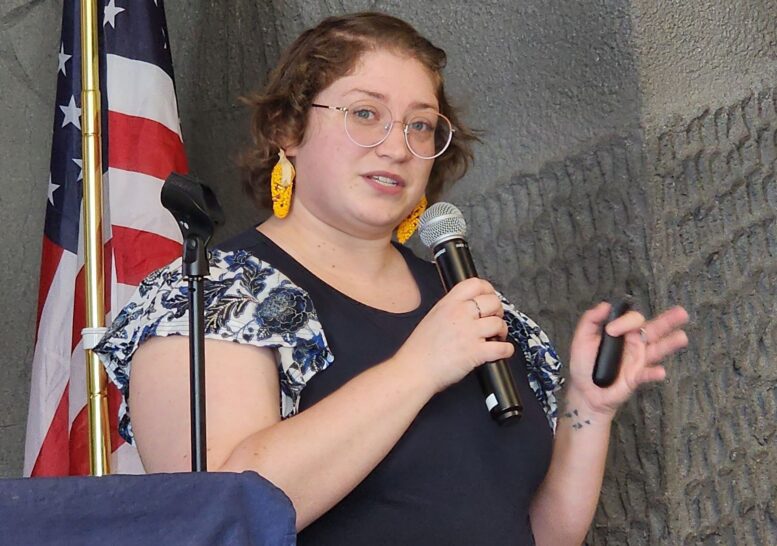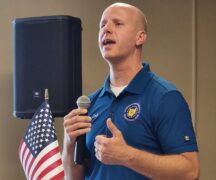By JAN McLAUGHLIN
BG Independent News
Corn is a regular ingredient in our diets, a constant component in our gas tanks, and a frequent backdrop in our classic movies.
Haley Shipley has been stalking corn’s claim to fame for her doctorate at Bowling Green State University. Two years into the American Culture Studies Ph.D. program, Shipley has come to some conclusions that she shared recently with the Bowling Green Kiwanis Club.
Wearing a pair of corncob earrings, she talked about the ubiquitous nature of corn.
While it had humble beginnings as scrawny stalks of teosinte, corn has outgrown that earlier version.
“We use corn in everything,” Shipley said.
Benjamin Franklin had high praise for the crop, using America’s corn crop in 1764 as an example of this nation’s superiority over England.
“Indian corn is one of the most agreeable and wholesome grains in the world; that its green ears roasted are a delicacy beyond expression,” Franklin wrote, adding that corn johnnycake, “hot from the fire, is better than a Yorkshire muffin.”
Hence, Haley’s title for her presentation was “From Benjamin Franklin to Broadway: Corn in Pop Culture.”
Haley, who grew up next to cornfields in Knox County, Ohio, has become keenly aware of corn’s presence in feeding people and livestock, in ethanol to fuel vehicles, and in pop culture.
In the late 1800s, cornfields had taken root primarily in the Midwest, where conditions are best for its growth.
“We live in Bowling Green, so we don’t have to go that far to see a cornfield,” she said.
On average, U.S. farmers plant about 90 million acres of corn each year, with the majority of the crop grown in the Heartland region, according to the USDA. Expanding ethanol production now accounts for nearly 45 percent of total corn use.
Corn is also processed into a multitude of food and industrial products including starch, sweeteners, corn oil, beverage and industrial alcohols, plus the making of water bottles and medicines. Corn is the primary U.S. feed grain, accounting for more than 95% of grain used to feed livestock.
But the focus of Shipley’s studies is the use of corn in pop culture.
During the Great Depression, popcorn was a dirt cheap snack to sell at movie theaters.
“Ninety years later, we’re still eating popcorn. It’s just not 5 cents anymore,” Shipley said.
During World War II, corn was portrayed as the “food of the nation,” with posters thanking citizens at home for sending corn to the troops overseas.
“Corn. That’s America. Everyone recognizes it,” she said.
It’s a beloved vegetable. Corn-on-the-cob means summertime, corny jokes are so wholesome they are laughable.
In movies, iconic cornfields make frequent appearances, usually creating feelings of nostalgia, goodness and home. Take the cornfields in the Wizard of Oz, opening scene of Oklahoma, The Music Man and, of course, Field of Dreams.
On rare occasion, cornfields shed their wholesome image, like in Children of the Corn, where “creepy kids in creepy corn” kill outsiders, Shipley said.
“I’m the worst person to watch movies with,” she said, explaining she is always on the lookout for corn. And when it appears, she always has to interpret its meaning.
“Most people don’t think about corn every single day,” unlike Shipley.
Shipley is determined to get to the Broadway musical called, “Shucked,” that reportedly has a seven-minute song just about corn.
“It’s research,” she assured of her motivation to see it.
But clearly, corn holds a place in pop culture that outranks any other vegetable, Shipley said. There aren’t many songs written about broccoli or spinach.
“Everyone knows what a cornfield looks like,” she said.
“There’s something about corn that seems to bring people together. Why not cauliflower? People don’t talk about cauliflower,” Shipley said, then quickly added, “I apologize if there’s a cauliflower farmer in the room.”





